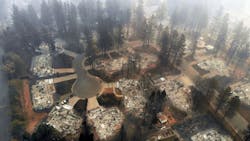Nov. 18 -- Thirteen months ago, a wildfire ripped through the homes of Sonoma County residents in the early-morning hours and killed 24 people who were unable to evacuate in time. County officials were later criticized for limiting the scope of their alerts to residents, and the Tubbs Fire tragedy was held up as a somber lesson in emergency management.
But a little more than a week since the Camp Fire ignited to become the deadliest and most destructive wildfire in California history — 76 people are dead and more than 1,000 are unaccounted for — the response by Butte County officials has raised questions about how far the state has come in the past year, and whether local governments are doing everything they can to warn people of the devastating blazes before they’re burning at their doors.
Last week’s inferno has become an all-too-familiar scene in what experts call the “new normal” as California’s climate changes, and, according to some experts, so was the response.
As the Camp Fire raced toward homes in Paradise and Magalia, Butte County Sheriff’s officials deployed on-foot evacuation crews and messages through an opt-in system called CodeRed. However, they failed to issue what’s known as a Wireless Emergency Alert, or WEA: a mass, Amber Alert-style message sent to all area cell phones that is specifically designed for an emergency such as a wildfire.
California agencies have nearly doubled their use of WEAs in 2018 compared with last year, and the system has been promoted in statewide legislation, various media reports and a pending “best practices” protocol to be issued by the state.
“What would have been nice to see in the Camp Fire (was a) WEA alert to let everyone know about the fire and to prepare accordingly,” said Thomas Cova, director of the Center for Natural & Technological Hazards at the University of Utah in Salt Lake City. “Even though it would have been followed shortly by an urgent evacuation notice, people — especially the less mobile — would have been given a fighting chance to ready themselves to go if they hadn’t left already.”
It’s unclear whether the alert could have saved lives lost in the Camp Fire. Cell phone service near Paradise is notoriously spotty, and many of the town’s elderly residents relied on land lines. A spokeswoman for the Butte County Sheriff’s Office said the fire might also have burned through cell towers.
A new law will require the state’s Office of Emergency Services to develop emergency notification protocols for counties and improve training and access to Wireless Emergency Alerts. The protocol is in draft form now, but most counties have already received a copy.
“It basically says the mass notification system is one of a number of tools in the toolbox,” said Paul Hess, emergency manager for the Alameda County Sheriff’s Office of Emergency Services. “And for an incident of this type, where you have a large fire, they recommend that you use as many of the tools in the toolbox as possible.”
The Tubbs Fire prompted officials in Sonoma County to register to send their own alerts. While emergency managers had access last year, now the county Sheriff’s Office does as well. The agency has issued two alerts and one test in the year since, said Misti Harris, a Sheriff’s Office spokeswoman.
Federal Emergency Management Agency data on WEA alerts show that local California agencies are growing increasingly comfortable with the system. City, county and state agencies issued 66 alerts last year, and 108 by mid-November 2018. The notifications were deployed for a variety of circumstances, including Amber Alerts, mandatory evacuations and test messages.
Butte County sheriff’s officials declined to answer questions about their decision not to issue WEA alerts. A spokeswoman said the office is still in “emergency response mode” and there’s been no time to analyze what actions were taken.
At the onset of the fire, the county relied on an opt-in system called CodeRed to alert residents of the approaching threat. Officials sent out about 5,000 emails, 26,000 reverse-911 calls and 5,400 text messages to those who signed up for the service.
“We know we used CodeRed messages. We used law enforcement officers in the area,” said spokeswoman Megan McMann. “No single notification system is 100 percent effective. That is made more difficult with how rapid this fire was moving. When this emergency is over, we will be able to put our attention toward this.”
Butte County, like dozens of other counties and cities in California, have WEA alerts at their disposal by signing up through FEMA’s Integrated Public Alert & Warning System, or IPAWS.
FEMA records show Butte County became an alerting authority in early 2014 but has not issued an alert since at least January 2017. Butte County also hasn’t used the IPAWS Lab Test or training equipment, an official told The Chronicle.
Butte County officials have not explained this inaction, but last year Sonoma County emergency managers said they feared the alert would have reached cell phones far from the area of the fire, potentially causing panic and gridlock during the evacuation. A report issued months later by the California Office of Emergency Services found that the county’s response fell short, and specifically criticized its decision not to issue a WEA.
Local emergency managers had a “limited awareness and understanding of the WEA system and outdated information regarding WEA’s technical capabilities,” the report said.
Cova and his colleagues study the way government agencies respond to natural disasters and emergencies, and they’ve found many officials are still unclear on WEA’s capabilities and its effects.
“There’s 50-plus years of research in disaster public response showing that alerts/warnings don’t cause panic in disaster events,” Cova wrote in an email.
He defined “panic” as a breakdown of reasoning when people take actions that aren’t in their best interest.
“It’s a common myth used to withhold information from the public in a disaster,” Cova said. “The real problem is lack of information to allow people to ‘mill’— seek further information and communicate with others — and ultimately build situational awareness and develop a plan to take protective action.”
Cova pointed to Ventura County’s response to the Thomas Fire on Dec. 4, 2017, as a testament to WEA’s value. County officials issued an alert noting the exact location of a “FAST MOVING BRUSH FIRE” and directed people to the county’s website. Though residents were stunned that the fire traveled so quickly, many were ready to go when asked to evacuate.
“End result: no fatalities,” Cova said, noting that two people were killed indirectly: a firefighter later died from smoke inhalation and a woman fleeing the fire was killed in a car accident.
Despite the ubiquity of cell phones, other officials counter that the WEA system is far from perfect.
“Right now the way it’s set up, you can’t fine-tune your coverage very well,” said Hess, who oversees Alameda County’s emergency responses. “If you select a county boundary, chances are it’s bleeding over (from Alameda) across the bay into San Francisco and San Mateo counties, probably hitting a lot more people than we intend.”
Federal officials are working to make the system’s alert areas more precise, Hess said.
“But we’re not there yet,” he said.
John Pohmajevich, 60, of Magalia (Butte County) said he didn’t receive an alert and “in a way I think it was wrong. But the way that fire happened, if it wouldn’t have been windy, the fire wouldn’t have done all this damage. The wind is what did all the damage.”
He said there was no way to predict how the Camp Fire exploded and commended the firefighters’ efforts.
Harris, a spokeswoman for the Sonoma County Sheriff’s Office, said the WEA alerts have been helpful, if imperfect, in three instances. The Sheriff’s Office issued an alert after an Aug. 3 explosion at a Guerneville Safeway during the town’s Lazy Bear weekend. With so many tourists in town celebrating the festival, Harris said, it was helpful to use the device’s feature for all cell phones in the geographic area.
But in a test run of the system, county officials found that some people who were in the targeted area didn’t receive the message, while others outside the area did.
“There’s a lot of inconsistency as to who received it,” Harris said.
The state’s new protocols are in draft form and under review, said Office of Emergency Services spokesman Kelly Huston. California won’t require local agencies to abide by one standard but rather will outline an assortment of alert options to choose from, including social media, WEAs, opt-in alerts and reverse-911 calls.
The goal is to educate emergency managers and allow them to choose the procedures best for their community. The plan that’s best for, say, Modoc County won’t look the same as the one for San Francisco.
“It’s hard to develop a standard when there’s not necessarily one way to do it,” Huston said. “Ultimately, it’s their decision, and they need to have the right tools to make that decision.”
San Francisco Chronicle staff writer Sarah Ravani contributed to this report.
___ (c)2018 the San Francisco Chronicle Visit the San Francisco Chronicle at www.sfgate.com Distributed by Tribune Content Agency, LLC.






